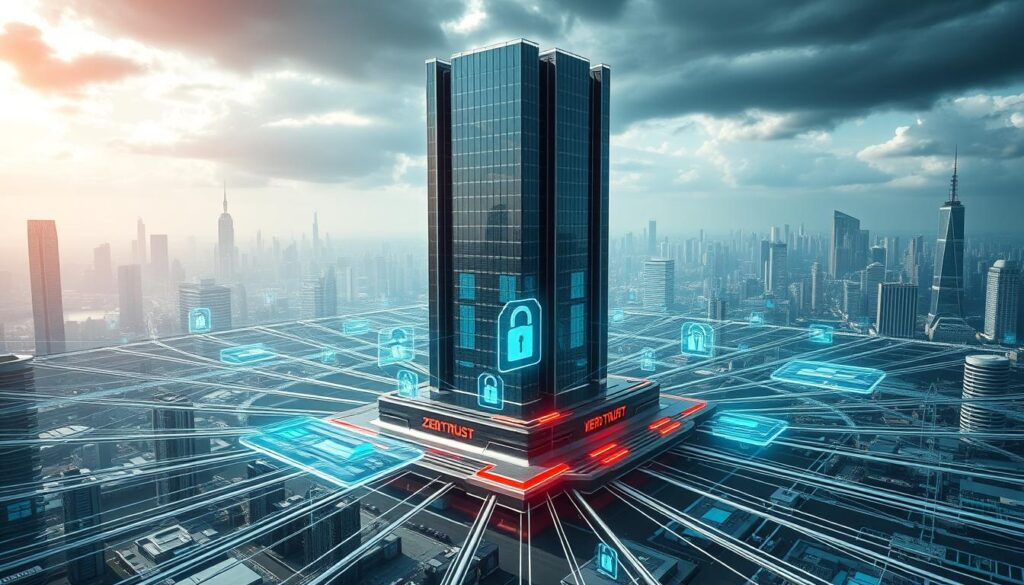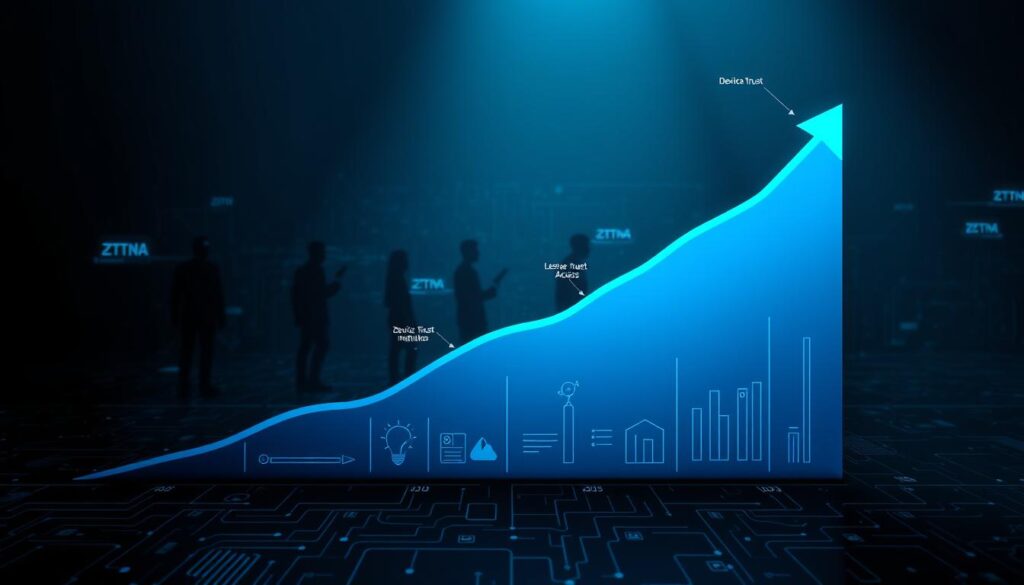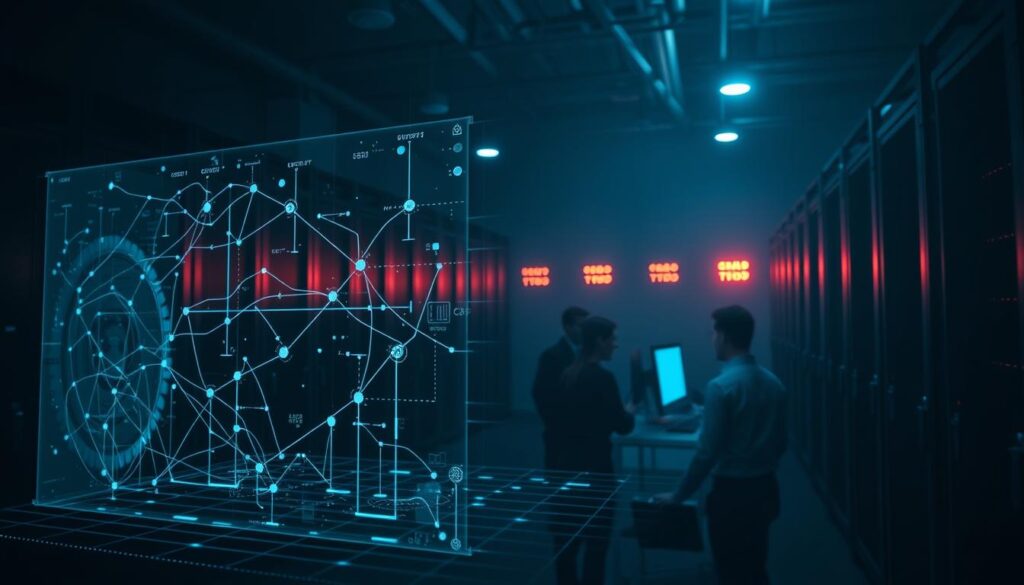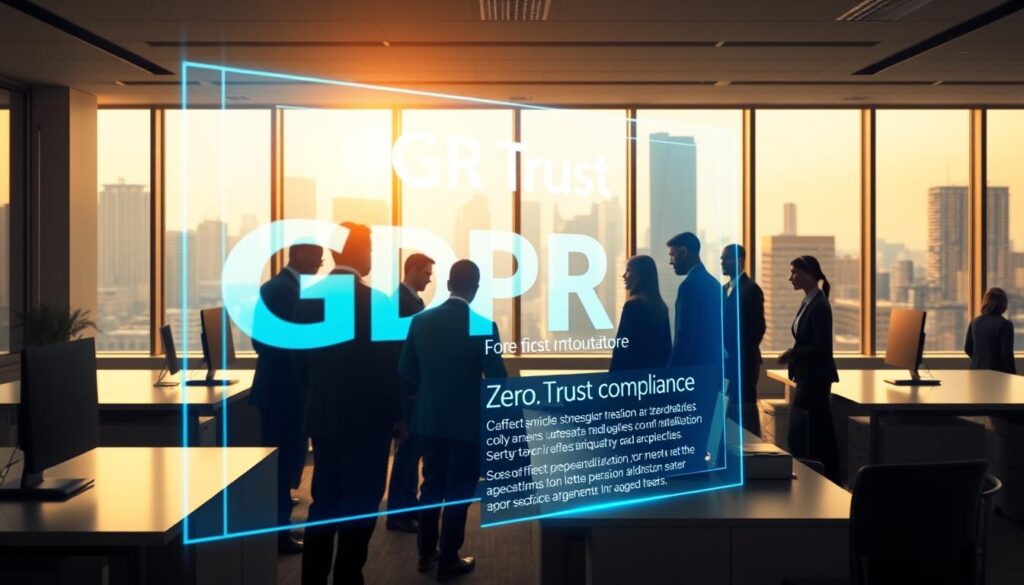
Cyber threats are evolving fast. Traditional security models no longer work against today’s sophisticated attacks. A new approach is needed—one that assumes no user or device is trustworthy by default.
Enter Zero-Trust Architecture. This framework verifies every access request, whether inside or outside the network. With AI-driven threats surging by 300%, businesses can’t afford weak defenses.
Leading companies like Zscaler already support over 8,000 customers, including 40% of the Fortune 500, with their Zero Trust Exchange. By 2025, experts predict 70% of enterprises will abandon outdated perimeter security.
Hybrid work and cloud migration push adoption further. But challenges remain, from legacy system upgrades to compliance hurdles. This article explores the technical, operational, and regulatory shifts ahead.
Key Takeaways
- Traditional security models fail against modern threats.
- Zero Trust verifies every access attempt, minimizing risks.
- AI-powered attacks demand stronger defenses.
- Major enterprises are adopting Zero Trust now.
- Legacy systems and regulations pose adoption challenges.
Why Zero-Trust Architecture Is the Future of Cybersecurity
Perimeter defenses crumble under modern attack techniques. Firewalls and VPNs, once reliable, now fail to protect cloud-native workflows. ZTNA (Zero Trust Network Access) emerges as the smarter alternative, verifying every request—inside or outside the network.
The Decline of Perimeter-Based Security Models
Legacy systems rely on outdated “trust but verify” rules. Today, 85% of breaches target cloud environments, where traditional firewalls fall short. A Fortune 500 company slashed breach attempts by 73% after switching to zero trust.
Zscaler reports a 400% surge in hybrid work attack surfaces since 2023. Remote employees accessing apps via VPNs create vulnerabilities. Direct application access, like Zscaler’s ZPA platform, eliminates these risks.
| Legacy Security | Modern Zero Trust |
|---|---|
| Network-centric | Identity-centric |
| VPN-dependent | ZTNA-driven |
| 3x higher maintenance costs | Scalable, cost-efficient |
Adoption Drivers: Hybrid Work and Cloud Migration
Gartner predicts 70% of remote access will use ZTNA by 2025. Cloud migration fuels this shift—68% of enterprises face security gaps during transitions.
Hybrid workforces demand flexible access without compromising safety. Unlike VPNs, ZTNA grants least-privilege permissions, reducing exposure. The result? Faster deployments and fewer threats.
Zero Trust as the Default Security Model by 2025
Businesses are rapidly ditching outdated security models for stronger protection. By 2025, zero trust will dominate enterprise strategies, fueled by hybrid work and cloud migration. The data proves it’s not just a trend—it’s a necessity.

ZTNA Replacing Legacy VPNs: What the Data Shows
Legacy VPNs can’t match modern demands. Zscaler Private Access (ZPA) responds to threats 92% faster than traditional VPNs. Latency drops by 65%, streamlining workflows for distributed teams.
Adoption rates reflect this advantage. Zscaler deployments grew 140% YoY, with enterprises prioritizing secure, scalable solutions. One Fortune 500 company cut breach attempts by 73% post-implementation.
SASE Consolidation and Single-Vendor Solutions
83% of enterprises now prefer single-vendor SASE platforms. Unified consoles, like Zscaler’s Experience Center, simplify security and network management. Partnerships with CrowdStrike and Okta enhance protection stacks.
The ROI is undeniable. Organizations save $2.7M on average by consolidating tools. By 2026, AI-powered SASE will embed real-time threat intelligence, closing gaps faster than ever.
AI and Automation: Redefining Zero-Trust Enforcement
Artificial intelligence is transforming security protocols at an unprecedented pace. Neural networks now analyze over 200 behavioral markers—keystroke dynamics, location patterns, even device tilt—to authenticate users continuously. This shift from passwords to context-aware verification slashes breach risks.

AI-Powered Continuous Authentication
Zscaler’s AI policy engine automates 89% of access decisions, reducing human error. For example, a healthcare provider cut false positives by 67% after deployment. The system cross-references dark web databases, flagging compromised credentials in under 3 seconds.
Proactive Threat Detection with Behavioral Analytics
Behavioral analytics catch 94% of insider threats pre-breach by spotting anomalies like unusual data downloads. One Fortune 500 firm saved 450 hours/year by automating responses. By 2026, generative AI models will predict attacks before they occur.
Overcoming Legacy System Challenges
Legacy systems create roadblocks for modern security upgrades. Aging infrastructure often lacks compatibility with newer technologies, forcing enterprises into costly workarounds. The average modernization effort costs $3.4M, but the risks of inaction are higher.
Interoperability Issues and Modernization Costs
Outdated systems struggle to communicate with cloud-native tools. One financial firm spent 14 months integrating security measures across mainframes and hybrid clouds. Phased migrations are preferred by 63% of organizations to minimize downtime.

Technical debt compounds these challenges. Zscaler’s API-first architecture cuts integration time by 73%, as seen in manufacturing clients. Their co-existence protocols bridge gaps between on-prem and cloud stacks.
Case Study: Zscaler’s Unified Platform Approach
A Fortune 500 manufacturer reduced legacy integration costs by 58% using Zscaler’s platform. Post-migration, they saw an 81% drop in breaches tied to outdated systems.
- ROI: 14-month payback period for financial services adopters.
- Risk Reduction: Real-time data monitoring slashes exposure.
- Scalability: Cloud-native tools grow with business needs.
Navigating Regulatory Complexities in Zero Trust
Global privacy laws are reshaping security strategies at an unprecedented scale. Over 92% of multinationals report Zero Trust delays due to GDPR and CCPA conflicts. Balancing security with data compliance requires precise controls—especially for cross-border workflows.

GDPR, CCPA, and Data Localization Hurdles
Article 32 of GDPR mandates technical measures like encryption and access logging. Zero Trust frameworks excel here, but data localization laws add complexity. For example, geofencing reduces cross-border violations by 79% by restricting data flows.
| Regulation | Zero Trust Alignment | Challenge |
|---|---|---|
| GDPR | Access logging, encryption | Data residency rules |
| CCPA/CPRA | User consent tracking | Real-time audits |
| Brazil’s LGPD | Role-based controls | Penalties up to 2% revenue |
Balancing Security with Cross-Border Data Compliance
Zscaler’s Data Protection Suite achieves 94% audit compliance by automating controls. Key integrations include:
- Blockchain consent management for CCPA transparency.
- Automated DPIAs (Data Protection Impact Assessments), cutting audit time by 68%.
- AI-driven policy engines that align with Article 32 requirements.
Proactive compliance reduces risks—firms using Zero Trust see $4.3M lower fines on average. The future hinges on tools that unify security and privacy without trade-offs.
Conclusion: The Path Forward for Zero Trust
Boardrooms now prioritize resilient frameworks over reactive fixes. With Zero Trust adoption growing at 54% CAGR, 89% of executives mandate immediate roadmaps. The next frontier? Convergence with quantum encryption and AI-driven policy engines.
Act now. Audit infrastructure, integrate AI, and budget for legacy upgrades. Delayers face a 78% breach risk by 2026—complacency is costly. For ongoing insights, leverage Zscaler ThreatLabz reports.
The goal is clear: Build self-healing ecosystems where security adapts autonomously. This isn’t just a trend—it’s the foundation of modern cybersecurity.
